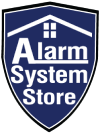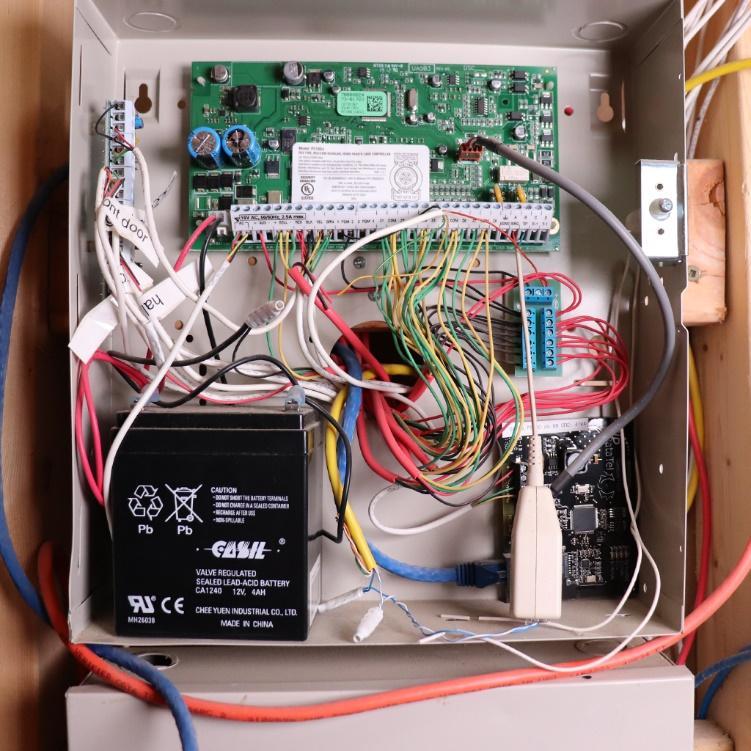
13 Aug 2019
- 0 Comment(s)
Security systems can be an interesting topic. One popular point for debate is not only which is better, hardwired or wireless, but also which security brand is the best. The PowerSeries Neo from DSC may just be the answer to both of these questions. Hardwired systems have historically been viewed as more stable and secure. But the installation, especially in a pre-existing building can be challenging even for a professional installer.

A typical hardwired alarm system control panel.
Wireless alarm systems, on the other hand, are quite simple to install but are generally more expensive. So it seems the ideal situation would be a hybrid system. One that features the ease of installation of wireless systems and the lower cost of a hardwired system. The DSC Power Series NEO is possibly the best solution on the market today due in large part to it’s advanced wireless technology. It is in a word, awesome and IMO is every bit as stable and reliable as a hardwired system, maybe more so even.
Before we jump into the details of the DSC PowerSeries Neo, many may ask, who is DSC? Many people have heard of other brands such as Honeywell but discount DSC because they think they are unfamiliar with it. Well, DSC is actually a major player in the security industry. Surely you have heard of Tyco. DSC was up until recently a Tyco International company. Tyco was acquired by Johnson Controls 2016 so it is now under their umbrella of companies. Johnson Controls is #272 on the Fortune 500. Certainly no small company.
PowerSeries Neo is the latest in a series of control panels that features several different models. DSC offers four control panels in the PowerSeries Neo family. These range in capacity from 16-128 zones and 2-8 partitions. Each control panel starts with six or eight hardwired inputs, two- four hardwired outputs and PSTN communication onboard. From there, the system can be tailored for specific installations with added expansion capabilities, features, and capabilities. This modular approach helps make the Neo system very dynamic and versatile. You can add the capabilities you require without paying for those that you do not. This versatility also helps to protect your investment by allowing for the future growth of the system. Remote firmware upgrades are supported for panels, keypads, and transceivers as well.
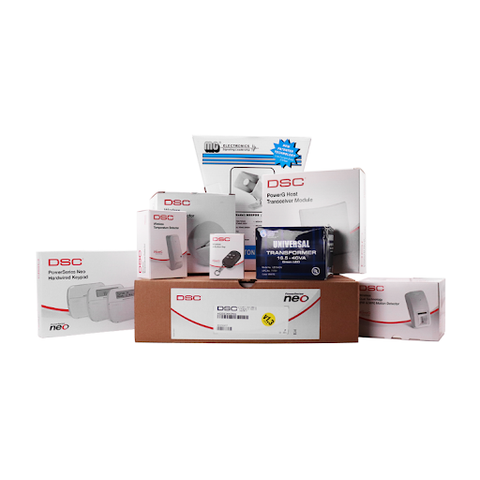
DSC’s PowerSeries Neo makes for a great hardwired / wireless hybrid security system.
As important as the main control panel is, the keypad is still your direct interface with the system. Keeping this in mind DSC has designed keypads for any type of installation. These include both hardwired, and even wireless keypads. The hardwired keypads are available with or without prox support as well as a built-in wireless transceiver. Keep in mind that DSC systems will support only 1 wireless transceiver per system. So if you would like Power G wireless capability for your system, only purchase 1 keypad with wireless transceiver or the HSM2HOST9.
If you would like a keypad at a remote location not easily accessible by wire, DSC has you covered. Wireless keypads are available utilizing the Power G technology we will discuss in a few moments. The wireless keypads not only feature optional prox support but there is even a model with voice prompts and announcing of system events. I personally love this feature because if I have an alarm go off in the middle of the night the keypad will announce the sensor in plain language so I can respond faster if need be.
If you really desire the most advanced way to access all of the features the Neo offers then the HS2TCHP touch screen keypad is the answer. The HS2TCHP is a state of the art hard wired keypad featuring a beautiful 7” full-color touchscreen. Also, you will notice the easy to read quick-view LED status indicators (Ready, Armed, Trouble and AC Power). If you have ever programmed zone labels on an LCD keypad you will especially appreciate the QWERTY keypad for labels. Since many of us are already familiar with DSC keypads there is even a “keypad” mode which acts just like a traditional keypad. And if all this was not enough it has a built-in and easy-to-update digital picture frame using an integrated SD card slot. Speaking of SD card slot, you can update firmware using that same SD card slot.
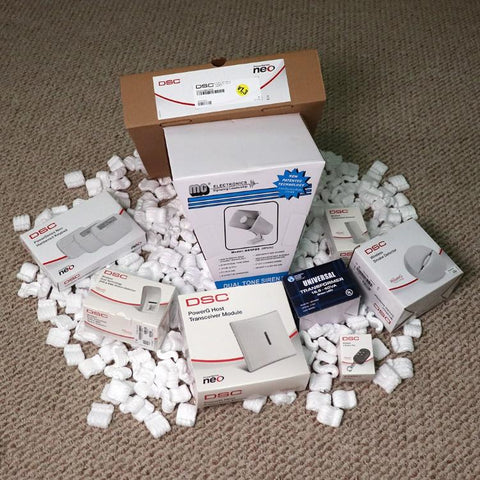
DSC PowerSeries Neo ready for a DIY install!
On many hybrid systems, wireless technology is like an afterthought. As if repackaging 20-year-old technology is “cutting edge”. Power G technology is unlike anything that has come before. Instead of getting too deep in high tech words, and pretending I totally grasp the technology, let's take a look at how that technology will affect us, the end user instead. That is something we can all understand.
Transmission Range: Typical wireless systems as we know them today are limited to 300 to 600 feet maximum. Power G destroys that limit! Testing has shown a line of sight distance of greater than 1 mile. That’s right, I said MILE. You may be thinking “no one has a home that is more than a mile across. While that is true it does speak to the strength of the Power G signal. If it can transmit more than a mile there should be no problem transmitting from your front door to anywhere in or on the house through all the walls and typical obstructions. And many people have a detached shop or mini barn that is now easily protected now with PowerG. If you do find that you need more range you can double it by using a Power G Repeater.
Wireless Reliability: Power G strives to provide the convenience of a wireless network with the reliability of a wired system. It achieves this by using “Frequency Hopping” technology. Signals continuously hop between channels in a random sequence, avoiding interferences and jamming. In addition, TDMA, (Time Division Multiple Access), assures that RF “collisions” are eliminated.
Energy Saving Technology: A serious objection many customers have with wireless transmitters is their reliance on battery power. With time and usage, batteries lose their charge. It’s just a fact of life. Power G wireless products feature a unique power saving technology. Each device continuously measures communication quality and automatically sets its transmission power to the minimum required for reliable communication with the panel. This ensures minimum, short transmissions while greatly extending the battery life of Power G devices to last up to 8 years!
System Security: The PowerG network utilizes the AES-128 encryption, protecting the system from code grabbing and message substitution by hackers and other attackers. The NSA, National Security Agency has stated that AES was secure enough to protect its information at the secret and top-secret levels. If it’s good enough for the NSA, it’s good enough for me.
Easy Enrollment: Power G wireless devices feature fast and convenient auto-enrollment. So rather than entering a long electronic serial number you simply push an enroll button and the sensor transmits the ESN to the panel. At that point, you follow a couple of simple prompts and the sensor is enrolled and ready to do its job.
Now that we understand the basics of the Power G technology let’s take a look at some of the sensors and devices that help make the Power G the industry leader.
For door and window protection there is the PG9975 and PG9945. The PG9975 is the least conspicuous of the two. It is so low profile that it is referred to as a “vanishing” contact. It blends so well that it almost appears that it “vanishes” into the background. For a more traditional sized contact, the PG9945 is the answer. In addition to being a door/window contact, it gives you the option of hardwire terminals so you can make a sensor that is currently wired a wireless sensor. This is great for use with wired contacts for overhead doors for example If your install calls for near invisibility then the PG9307 is the solution. The PG9307 is a recessed door/window contact that features an ultra-thin magnet which reduces the need for drilling. If you need a wireless outdoor contact for something like an outside gate or shed maybe, the PG9312 provides exceptional outdoor protection of windows, gates, and doors.
Motion sensors are an increasingly popular option. Most manufacturers produce one or two wireless motion sensors. The DSC Power Series NEO offers 8 separate motion sensors models depending on your needs. Everything from a basic indoor PIR, to an outdoor sensor with an integrated camera. Particularly interesting is the new PG9862 360-degree ceiling mount motion sensor.
In addition to intrusion protection, the Power Series NEO offers a full complement of safety devices. These include the PG9936 wireless smoke and heat detector, PG9933 CO detector and the PG9985 wireless flood detector.
Since the Power G wireless is 2-way wireless, the Neo can support wireless sirens as well. For indoor sirens, we have the PG9901. And for outdoors there is the PG9911 siren with built-in strobe.
One often overlooked wireless item is a wireless key. Often referred to as “key fobs” these wireless keys, depending on the model, can arm, disarm or even trigger a “panic” alarm. Another popular arming device is the “prox” tag. To arm or disarm with a prox tag you simply wave a mini prox tag (MPT) in front of a prox equipped keypad and it is done. Prox tags are a great choice if you don’t want to trust a key fob to an absent-minded family member. If a prox tag comes up missing, just unenroll it!
Without some means communication, your alarm system is just a high priced noise-maker. The Neo line is great for those looking for either self monitoring or professional central station alarm monitoring. DSC has partnered with Alarm.com to offer industry-leading interactive services to support its intrusion security products. Communication with alarm.com is provided by the TL880LTVZ or TL880LEAT. These are dual-path communicators, one for Verizon and one for ATT.
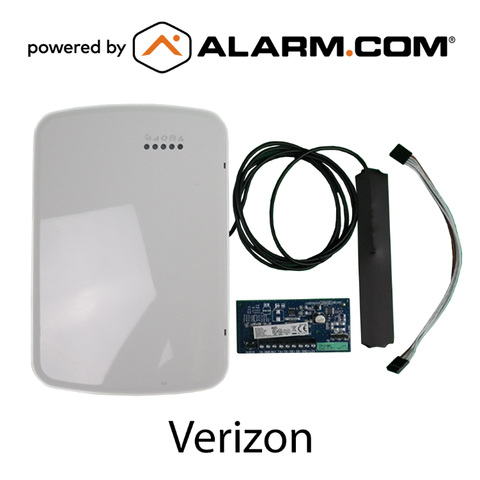
DSC TL880 dual path communicator.
Dual-path communicators use a cellular signal but also have a backup internet connection in case there is cellular signal trouble. This redundancy helps assure that you and or the central station receive alerts. With one of these communicators and alarm.com interactive services you can control Z-Wave sensors, remote arm/disarm and other functions from web portal or smartphone application. These communicators can also transmit to virtually any central station you might wish to use.
Now, back to the original title of this article. DSC PowerSeries Neo - Is It The Best Security System For You?
A few simple questions can help make up our mind.
1. Are you a rocket scientist? If the answer is No then the Power Series Neo may be for you. If the answer is yes, that’s ok too of course.
2. Would you like a system with the reliability of hard-wired and the ease of installation of wireless?
3. Do you need between 1 and 128 zones on your new alarm system?
4. Would you like a system that is easy and intuitive to program and operate?
5. Would you like to have a wireless system with a line of sight range greater than 1 mile?
6. Would you like a wireless system with encryption deemed strong enough for “secret” and “top secret” information by the NSA, National Security Agency?
Why wouldn’t the DSC Power Series Neo be the best system for you?
